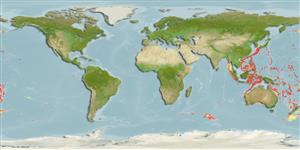Classification / Names
Common names | Synonyms | Catalog of Fishes(genus, species) | ITIS | CoL | WoRMS | Cloffa
Teleostei (teleosts) >
Acropomatiformes (Oceanic basses) >
Synagropidae (Splitfin ocean-basses)
Eponymy: Dr Naohide Nakayama is a Japanese ichthyologist who is (2018) Assistant Professor in the Department of Marine Biology at the School of Marine Science and Technology, Tokai University. [...] (Ref. 128868), visit book page.
Environment: milieu / climate zone / depth range / distribution range
Ecology
Marine; bathydemersal; depth range 216 - 794 m (Ref. 116586). Subtropical
Distribution
Countries | FAO areas | Ecosystems | Occurrences | Point map | Introductions | Faunafri
Western Pacific, known from southern Japan, Taiwan, the northern Philippines, to off Vanuatu and Wallis and Futuna; including Eastern Indian Ocean, Timor Sea and off northwestern Australia,
Size / Weight / Age
Maturity: Lm ? range ? - ? cm
Max length : 11.0 cm SL male/unsexed; (Ref. 116586)
Short description
Identification keys | Morphology | Morphometrics
Dorsal spines (total): 10; Dorsal soft rays (total): 8 - 9; Anal spines: 2; Anal soft rays: 7. This slender species is distinguished by the following characters: flat dorsal head profile and pointed snout; A II + 7; pectoral-fin rays 15-16, pectoral length 19.5-24.3% SL; gill rakers 11-16, decreasing with size; pseudobranchial filaments 16-29, increasing in number with fish growth; first anal-fin pterygiophore is long, slightly bent, with moderately broad, hollow tip; vomer V-shaped with reduced dentition, only few long teeth near sides of base; palatine with 1 row of teeth, anteriorly long, posteriorly granular; ectopterygoid widened, 3-4 rows of granular teeth; orbital diameter 9.5-12.6% SL, decreasing with size; snout length 87-113 % of orbital diameter; no longitudinal ridges on the preopercular lobe; otolith moderately slender (OL:OH = 1.7-1.8) (Ref. 116586).
Life cycle and mating behavior
Maturity | Reproduction | Spawning | Eggs | Fecundity | Larvae
Schwarzhans, W.W. and A.M. Prokofiev, 2017. Reappraisal of Synagrops, Günther, 1887 with rehabilitation and revision of Parascombrops Alcock, 1889 including description of seven new species and two new genera (Perciformes: Acropomatidae). Zootaxa 4260(1):1-74. (Ref. 116586)
IUCN Red List Status (Ref. 130435: Version 2024-1)
Threat to humans
Harmless
Human uses
Tools
Special reports
Download XML
Internet sources
Estimates based on models
Phylogenetic diversity index (Ref.
82804): PD
50 = 0.5001 [Uniqueness, from 0.5 = low to 2.0 = high].
Bayesian length-weight: a=0.00977 (0.00436 - 0.02192), b=3.01 (2.81 - 3.21), in cm total length, based on LWR estimates for this (Sub)family-body shape (Ref.
93245).
Trophic level (Ref.
69278): 3.5 ±0.5 se; based on size and trophs of closest relatives
Fishing Vulnerability (Ref.
59153): Low vulnerability (10 of 100).
